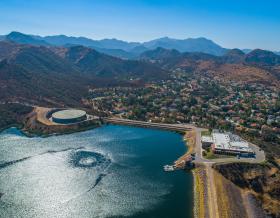A View on the Future of Decarbonizing Energy and Power: A Q&A with Andy Solberg
Global director for decarbonization talks about the transformation of energy demand and supply, and Jacobs role as an accelerator of energy transition solutions

The energy and power industries are undergoing unprecedented disruption on a global scale. The future of our world – economically, socially, technologically and environmentally – hinges on the evolution of energy systems, networks and infrastructure across all sectors and geographies.
From advanced manufacturing to water, global security and beyond, the industries that form the backbone of prosperous communities and economies depend on resilient, sustainable and secure energy.
Jacobs plays a key role on both energy supply and demand. We have tremendous opportunity to define how energy is used in all of our markets including advanced manufacturing, data centers, transportation, water treatment facilities, cities, communities, and places, as well as the opportunity to lead in how carbon free energy is generated and balanced with dynamic demand requirements.
Our solutions turn the energy problem into a growth enabler for our clients, with practitioners like Global Solutions Director for Decarbonization, Andy Solberg, and his team accelerating the energy transition for our clients around the globe. In this Q&A, we connect with Andy to discuss the trends and opportunities on how to lay the foundation for a more prosperous, sustainable future.
Tell us a bit about what a day in the life is like as Jacobs Global Solutions Director for Decarbonization, and what we offer to our clients in this area?
My role is to bring clear and concise energy transition solutions to Jacobs’ clients and projects, and to help grow our services and teams that deliver those solutions. There’s a basic approach to decarbonization and a core set of energy solutions that are ready to go, and my role is to help identify which solutions are applicable to the client’s business, commitments and aspirations. All of Jacobs’ end markets including advanced facilities, cities & places, energy & power, environmental, transportation, water, and governments around the world, have unique energy drivers, capital constraints and timing that needs to be sorted out – and that’s where our team comes in.
What are the biggest opportunities for growth in energy and power?
Global CO2 emissions related to fossil-based energy are still rising, but a plateau is finally emerging. The urgency to decarbonize will only grow stronger as negative impacts of climate change are experienced directly, such as natural disasters, ecological system loss, water and food scarcity and coastal flooding. There are several pathways accelerating this transition:
Energy use: Opportunities include optimizing power demand and providing carbon free power solutions for data centers, steel manufactures, ports and airports, water treatment facilities and net zero nature positive buildings, campuses and city places.
Energy supply: Opportunities are delivering power via three 24x7 carbon free energy pathways 1) renewable energy and energy storage 2) gas power generation with carbon capture and 3) nuclear power generation. Providing power from these generation pathways to energy users requires new power transmission and distribution. Ultimately, the grid capacity will need to be 3-5x the current capacity to handle electrification in the future.
Energy storage: As the percentage of renewable energy grows, both long and short duration storage technologies will become critical for stable resilient power. We see opportunities in all types of storage including hydrogen, lithium-ion batteries, pumped hydro, compressed air, flow, heat batteries or iron-air batteries, and other emerging technologies. In particular, green hydrogen (hydrogen production) is a key long duration energy storage medium that’s becoming more prevalent, and has direct use in power generation as well as in the creation of “drop-in” e-fuels for aviation and maritime decarbonization.
Additionally, there’s an opportunity to support building out of new resources and programs to support energy transition load growth, supporting transmission and distribution and new models of implementing emerging energy solutions.
How are we helping our clients think differently about their carbon footprint?
Many leaders, including the C-Suite, often do not fully understand their company’s carbon footprint and the potential actions and cost to change it. This sometimes can lead to a very careful and slow implementation, leading to failed decarbonization commitments as an organization.
Jacobs provides quick insight into what’s possible, and especially the impact on our clients’ businesses. Ultimately, we help clients create actionable roadmaps to decarbonize their operations and provide confidence in goals that are shared with investors, customers and stakeholders.
Is there a project you’re particularly proud of?
I’m particularly proud of an offering of solutions, projects and Jacobs teammates that directly result in 24/7 carbon free energy and enable it. 24/7 carbon free energy is where every hour of energy demand is matched with clean energy and is the end state of decarbonization. It is a goal that was fostered by clients we work with and now championed by the United Nations.
We provided this vision of hourly clean energy balance via the Star Peak Energy Center project over a decade ago and have been applying the same energy balance approach and renewable energy generation technologies ever since. Most recently, there have been projects involving long duration energy storage, including flow batteries, underwater compressed air, heat batteries, hydrogen generation and storage, and hydrogen derived fuels. All these projects leverage low-cost renewable energy and are key enablers to 24/7 carbon free energy.
What excites you for what’s ahead in the market?
My excitement really lies in Jacobs’ potential for impact. We have tremendous intellectual breadth as trusted advisors and integrators of nearly all aspects of energy use and generation. If you look at an energy flow diagram for the world it looks like a breakdown of Jacobs’ end markets. So collectively if each Jacobs market set a goal, say 10% reduction by 2030, collectively just our company could drive a significant movement toward both 2030 and 2050 goals.
This is a tremendous growth opportunity for Jacobs, with thousands of careers in the making, and I’m excited to grow, teach and mentor others to help continue delivering this impact!
About the interviewee

Andy Solberg is Jacobs’ Global Market Solutions Director for Decarbonization within Energy and Power where he focuses on solutions that enable resilient 24x7 carbon free energy to data centers, manufacturing facilities, water treatment facilities, transportation systems, buildings and more. He has over 27 years of experience in net zero building design, manufacturing facility design, energy master planning, system simulation, and implementation of renewable energy and energy storage. He and his family “walk the talk” and are well down the path of decarbonization. He has decarbonized most everything. house, cars and hobbies (backpacking, sailing, backcountry skiing) and uses a mix of onsite solar and utility green power for their daily lives.












































